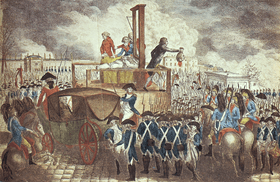Public execution

A public execution is a form of capital punishment which "members of the general public may voluntarily attend." This definition excludes the presence of a small number of witnesses randomly selected to assure executive accountability.[1]
While today most countries regard public executions with distaste, in the past they were preferred to executions behind closed doors because they allowed the victim the opportunity to make a final speech, gave the state the chance to display its power in front of those who fell under its jurisdiction, and granted the public what was considered to be a great spectacle.[2] Public executions also permitted the state to project its superiority over political opponents.[2] Thus, when Charles I of England was beheaded, the reduced height of the block meant that he could not assume the normal kneeling pose, but was forced to lie in a face-down position considered to be especially humiliating.[2]
In Europe and in the northern U.S., the 19th and early 20th centuries saw a shift away from the spectacle of public corporal punishment and toward administration of punishment via the deprivation of liberty.[3] While some reformers opposed capital punishment, public executions remained common throughout the 19th and early 20th centuries.[3] Social historians note that beginning in the 20th century in the U.S. and western Europe death in general became increasingly shielded from public view, occurring more and more behind the closed doors of the hospital.[3] Executions were likewise moved behind the walls of the penitentiary.[3] The last formal public executions occurred in 1868 in Britain, in 1936 in the U.S. and in 1939 in France.[3]
According to Amnesty International, in 2012 "public executions were known to have been carried out in Iran, North Korea, Saudi Arabia and Somalia."[4] Amnesty International does not include Syria, Afghanistan, and Yemen in their list of public execution countries, but there have been reports of public executions carried out there by state and non-state actors.[5][6][7] Executions which can be classified as public were also carried out in the U.S. states of Florida and Utah as of 1992.[1]
See also
References
- 1 2 Blum, Steven A. (Winter 1992). "Public Executions: Understand the "Cruel and Unusual Punishments" Clause" (PDF). Hastings Constitutional Law Quarterly. 19 (2): 415.
- 1 2 3 Cawthorne, Nigel (2006). Public Executions: From Ancient Rome to the Present Day. pp. 6–7. ISBN 978-0-7858-2119-9.
- 1 2 3 4 5 William J. Chambliss (2011). Corrections. SAGE Publications. pp. 4–5.
- ↑ Rogers, Simon; Chalabi, Mona (2013-12-13). "Death penalty statistics, country by country". The Guardian. Retrieved 2015-12-13.
- ↑ "ISIS extremist reportedly kills his mother in public execution in Syria". Fox News. 2016-01-08. Retrieved 2016-05-30.
- ↑ Cohen, Tamara (2009-07-07). "Justice Yemen-style: Paedophile who raped boy, 11, shot in the head in front of hundreds of spectators | Daily Mail Online". Dailymail.co.uk. Retrieved 2016-05-30.
- ↑ Updated 6:21 AM ET, Mon July 9, 2012 (2012-07-09). "Video: Taliban shoot woman 9 times in public execution as men cheer". CNN. Retrieved 2016-05-30.
